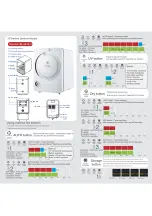
S
ection
5 — o
peration
17
Choosing Wheel & Tine Speeds
The tiller has four FORWARD wheel/tine speed combinations for
handling a variety of tilling tasks and gardening jobs. Experiment
with the tine depth, engine speed, and wheel/tine speed to
determine the combination that provides the best results. Here
are some tips:
1.
Advance the throttle lever so the engine has sufficient
power.
WHEEL SPEED AND BELT RANGE SELECTION GUIDE
SLOW GEAR, LOW BELT RANGE
For:
1.
Tilling in sod.
2.
Tilling in hard clay.
3.
Tilling under standing
cornstalks in tough soil
conditions.
4.
Tilling under cover crops.
5.
Preparing a deep
seedbed.
6.
Tilling in stony soil.
7.
Tilling under residues
and organic matter.
8.
Mixing in fertilizers,
manure.
SLOW GEAR, HIGH BELT RANGE
For:
1.
Tilling in sod or hard clay.
2.
Tilling under standing
cornstalks (slow, steady
speed allows time to
shred stalks).
3.
Tilling under cover crops
(best wheel speed and
belt speed range in most
soils).
4.
Preparing seedbeds
(best speed choice in
most soils).
5.
Tilling in stony ground.
6.
Building raised garden
beds.
7.
Mixing in fertilizer.
8.
Using tiller wings in hard
soil.
9.
Mixing fertilizer and
manure.
10. Tilling residues and
organics.
FAST GEAR, LOW BELT RANGE
For:
1.
Going over seedbed
for the last time before
planting crops.
2.
Covering over seeds in
wide row or plot planting
(lift handlebars to avoid
going too deep).
3.
Hilling and furrowing.
4.
Making raised beds.
5.
Cultivating (lift
handlebars to avoid
going too deep).
6.
Tilling large areas.
7.
Tilling organic matter in.
8.
Cultivating between
raised beds with
optional hiller/furrower
attachment.
FAST GEAR, HIGH BELT RANGE
For:
1.
Preparing seedbeds for
planting.
2.
Covering seeds with
less need to hold up the
handlebars.
3.
Cultivating (tiller travels
faster, rides higher on
the soil; allows engine
RPM to be reduced;
handlebars don’t have to
be raised).
4.
Keeping large areas tilled
and cultivated in the
summer.
5.
Tilling organic matter
under.
6.
Moving tiller quickly.
7.
Cultivating between
raised beds using the
optional hiller/furrower.
2.
When tilling untilled or hard earth, do not set the Depth
Regulator too deep. The tiller will buck and the engine will
load down.
3.
You will know your settings are ideal when the tines
break-up the soil easily, the engine does not labor, and your
progress is steady and smooth. See Figure 5-5.
Changing Belt speed
Your tiller has two belt-driven speed ranges — HIGH RANGE and
LOW RANGE — you pick one or the other by deciding which set
of pulley grooves to move the forward belt into. By moving the
belt from one speed range into the other, in combination with
the FAST and SLOW wheel speeds, you obtain a choice of four
different forward wheel speeds and two different tine speeds.
WARNING!
To help avoid serious personal injury,
stop the engine, remove the ignition key, disconnect
spark plug wire and move the wire away from the
spark plug and let engine and muffler cool down
before changing the belt speeds.
Changing the belt from LOW range into HIGH range (or back
again) is a matter of moving the belt from one set of pulley
grooves to a second set of pulley grooves. This change is done
quickly and without tools.
When the tiller is moving in REVERSE, the wheels are powered by
a rubber reverse disc, not by the belt. Therefore, you have only
two reverse speeds SLOW and FAST, as set with the Wheel Speed
Lever.
Figure 5-6 shows the range of wheel and tine speeds available
when using the two belt speed ranges and the FAST and SLOW
selections on the Wheel Speed Lever.
Available wheel and tine speeds at 3000 RPM engine speed.
Belt
Position
Wheel Speed
Lever
Wheel Speed
Tine
Speed
Low Range
Slow
.5 MPH
146RPM
Low Range
Fast
1.2 MPH
146RPM
High Range
Slow
.7 MPH
200RPM
High Range
Fast
1.72 MPH
200RPM
Figure 5-6
Figure 5-5
Summary of Contents for Big Red
Page 43: ...Notes 10 43...
















































